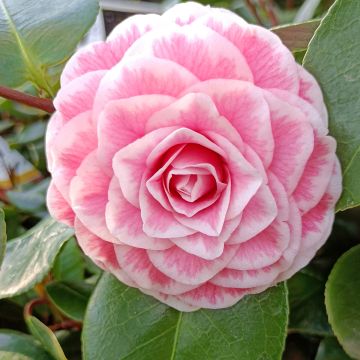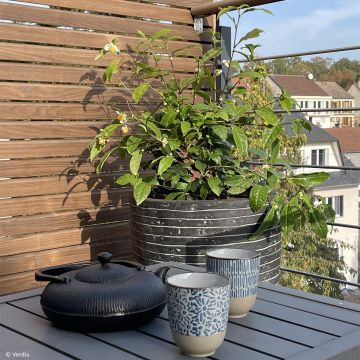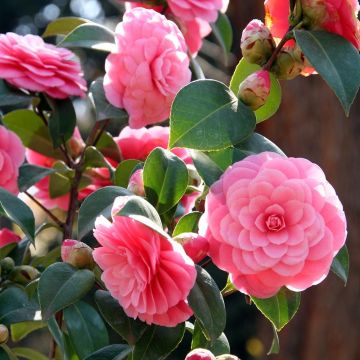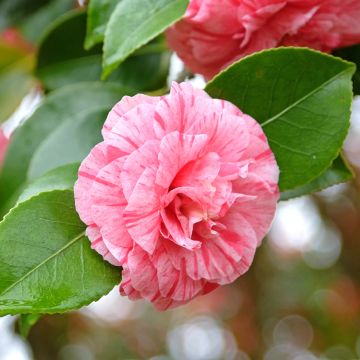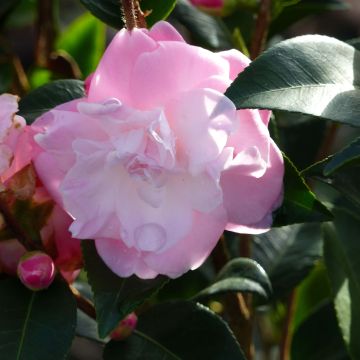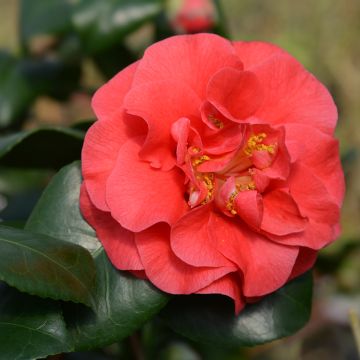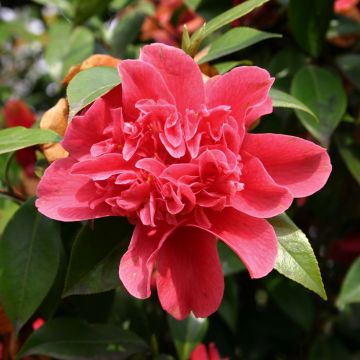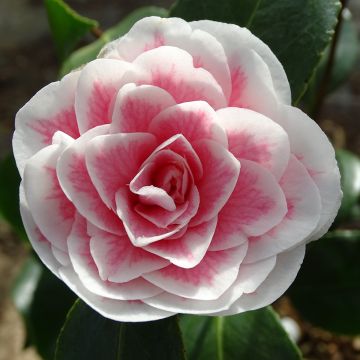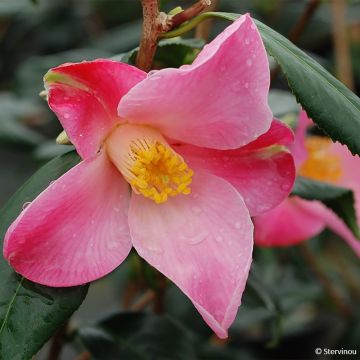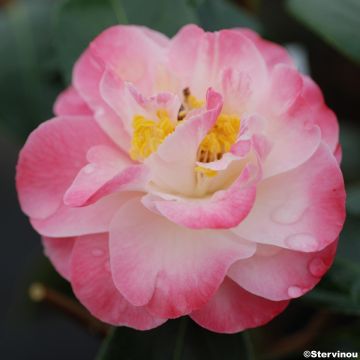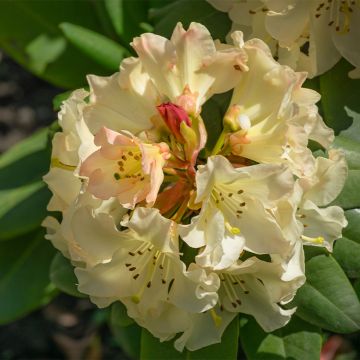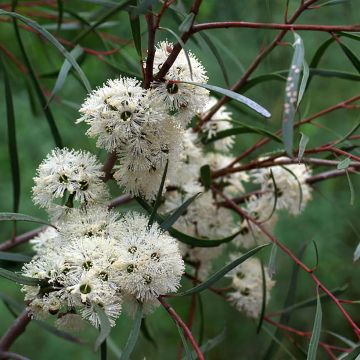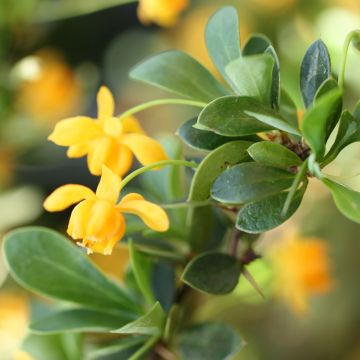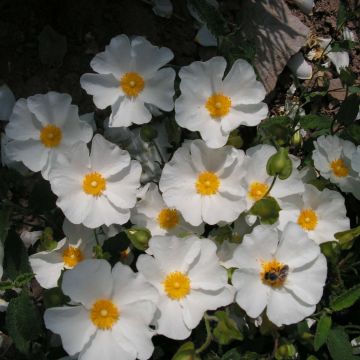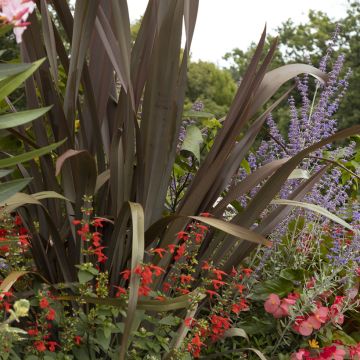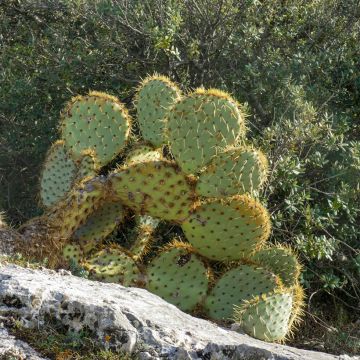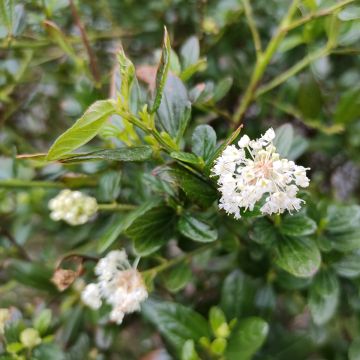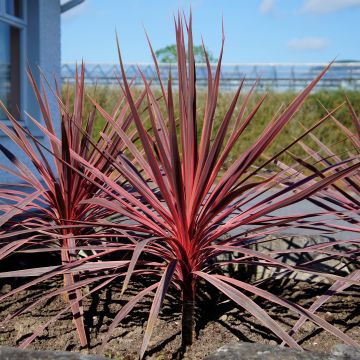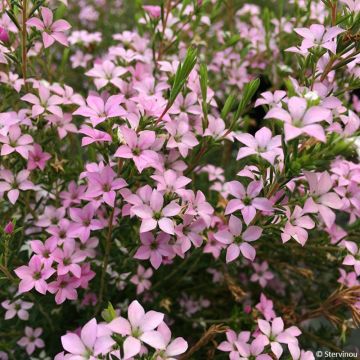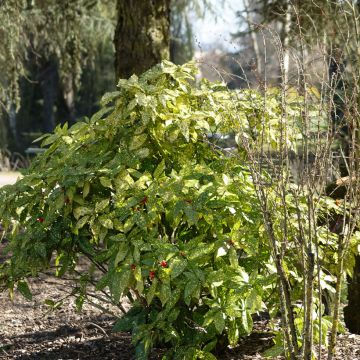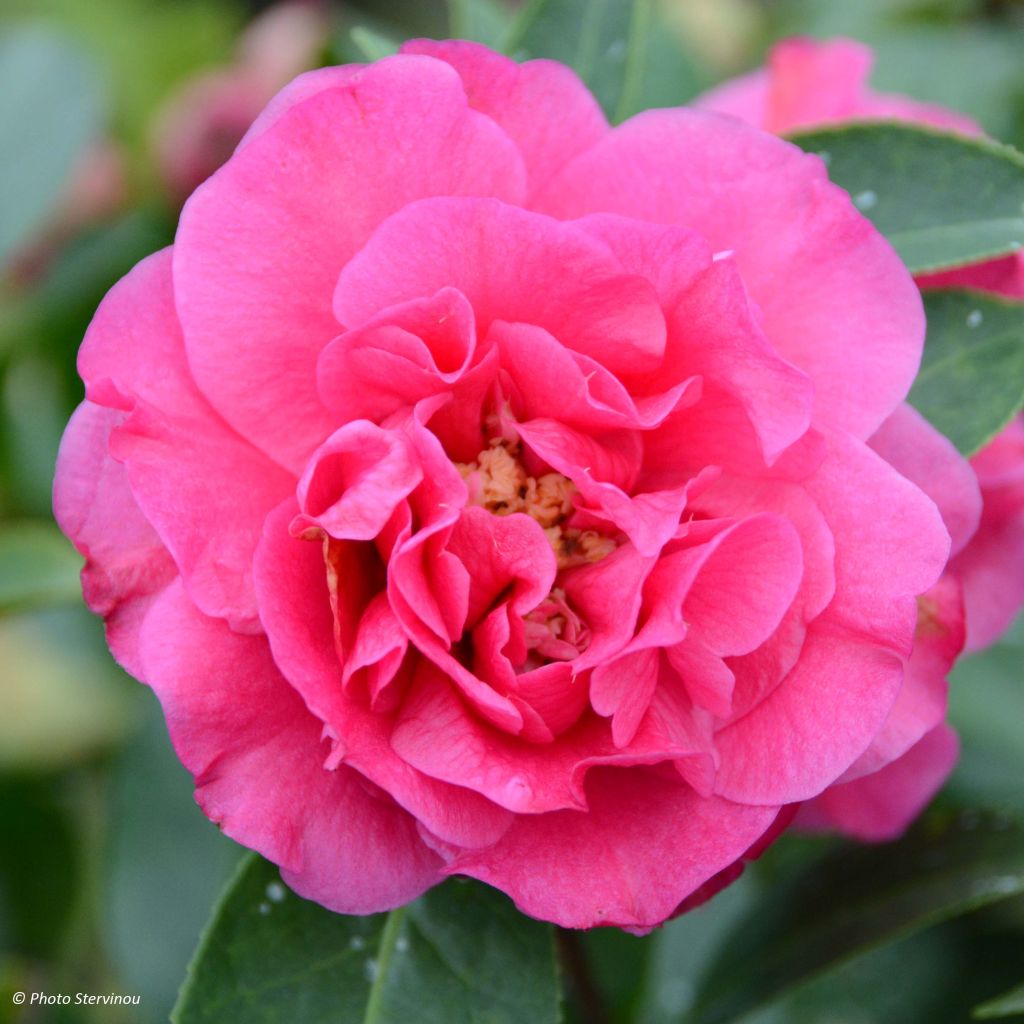

Camellia reticulata Fiesta Grande
Camellia reticulata Fiesta Grande
Camellia x reticulata Fiesta Grande
The young plant looks healthy with lots of buds, despite the fact that it was delivered to me upside down (the tape that closed the box and had the word "fragile" on it was stuck the wrong way round!!! The only flower that had opened was broken, the soil was spilled...
Dominique V., 06/03/2020
This item cannot be shipped to the selected country
Delivery charge from €5.90
More information
Schedule delivery date,
and select date in basket
This plant carries a 24 months recovery warranty
More information
We guarantee the quality of our plants for a full growing cycle, and will replace at our expense any plant that fails to recover under normal climatic and planting conditions.
From €5.90 for pickup delivery and €6.90 for home delivery
Express home delivery from €8.90.
Does this plant fit my garden?
Set up your Plantfit profile →
Description
Camellia 'Fiesta Grande is an old variety of hybrid camellia that is absolutely splendid: the bush, with an upright and relatively dense habit, produces very beautiful flowers that resemble certain peonies, in a rare lilac-pink color. They are opulent, semi-double, and appear over a long period in winter and early spring. They bloom on a moderately vigorous plant, dressed in elegant foliage, with a shiny dark green colour. Slightly more frost-sensitive than the Japanese camellia, and capable of adapting to sunny sites. However, this beautiful bush requires moist soil in summer that is limestone-free. Plant in a pot on a terrace, alone in the garden, or in a small flowering hedge.
The Camellia 'Fiesta Grande', developed in California by Meyer Piet and Lee Gaeta before 1884, belongs to the family of Theaceae. It is the result of the cross-breeding between Camellia reticulata, a large and slightly frost-sensitive species native to the Chinese province of Yunnan, and Camellia sasanqua, an autumn camellia from southern Japan. It is a bushy and rather upright shrub that will reach about 1.20 m (3 ft 11 in) in height and 80 cm (31.5 in) in width after 10 years. At maturity, after 15 to 20 years, it will measure an average of 2 m (6 ft 7 in) in height and 1.50 m (4 ft 11 in) in width. From February to April it produces light purple flower buds. They open into flowers with a diameter of 10-11 cm (4 in) that resemble both anemones and peonies. Each flower is composed of numerous fine-textured petals, smaller towards the centre, pink in colour with lavender reflections. A few bashful yellow stamens appear when fully bloomed. The evergreen foliage resembles that of Camellia sasanqua. It consists of large elliptical leaves, 7 to 9 cm (2.8 to 3.5 in) long and 4-5 cm (1.6-2 in) wide, leathery, finely toothed at the edges, dark green and shiny on the upper side. While this shrub is hardy down to -12°C in open ground, its flower buds can be destroyed by snow, icy winds, and temperatures below -5°C (23 °F).
Camellia 'Fiesta Grande' prefers mild and humid climates and thrives in coastal regions, in acidic, humus-rich, and well-drained soil. It will tolerate full sun in favourable climates, but will give its best in partial shade or even shade, protected from intense sunlight and sheltered from strong winds. Wherever winter is not too harsh, it can be planted in isolation in the garden, or combined with other ericaceous plants such as Rhododendrons, Azaleas, Cornus Kousa, Hydrangeas, Hamamelis, or even Kalmia Latifolia. It deserves a prominent position, at the entrance of the garden or along a path. You can plant autumn bulbs such as colchicums or cyclamens around its base. In cold regions it can be grown on a balcony or terrace, and brought in to a veranda or cool greenhouse during the flowering period. It can be protected from the cold in a lightly heated apartment, provided its foliage is regularly misted and it is watered with non-calcereous water.
Report an error about the product description
Camellia reticulata Fiesta Grande in pictures
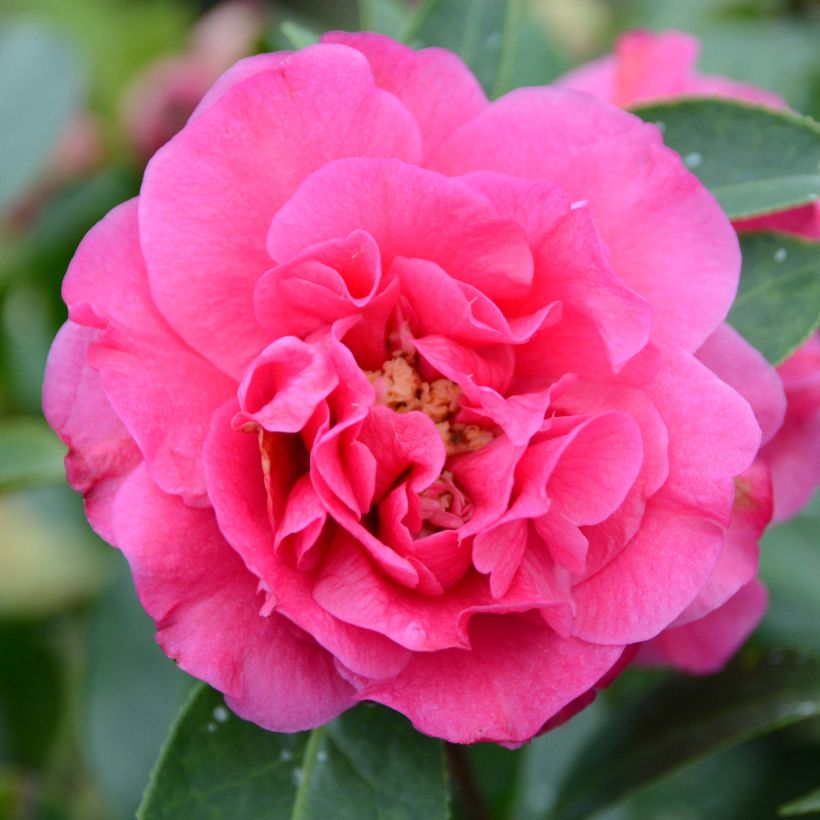

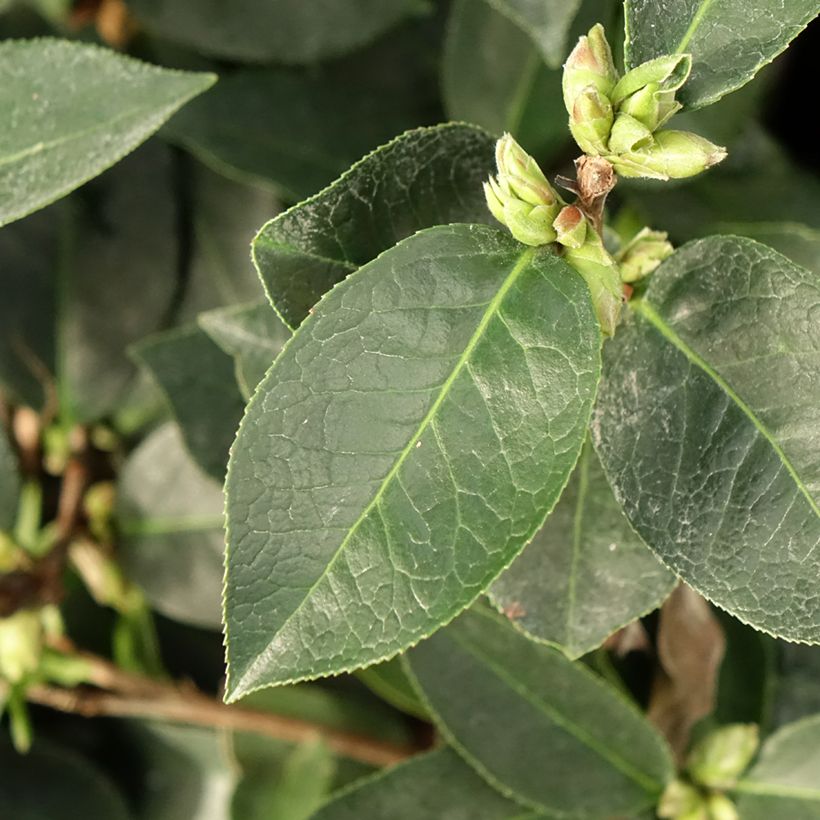

Plant habit
Flowering
Foliage
Botanical data
Camellia
x reticulata
Fiesta Grande
Theaceae
Cultivar or hybrid
Other Traditional Camellia
Planting and care
Camellia 'Fiesta Grande' tolerates full, not-too-strong sun, but performs best in partial shade or shade, protected from intense sunlight and sheltered from strong winds. Plant in a cool, humus-rich, acidic, and well-drained soil. Do not plant the bush too deeply, the top of the root ball should be covered with 3 cm (1.2 in) of soil. In winter, cover it with a 5 to 7 cm (2 to 2.8 in) thick mulch composed of leaf compost and crushed bark. Beware of late frosts that can damage the flowers and buds. During dry periods, water the bush to prevent the dropping of flower buds. It is recommended to plant camellias in autumn to promote good root growth and better flowering during the first year. Possible diseases include chlorosis caused by excess limestone, brown spots caused by burns on leaves exposed to full sun, sooty mould, scale insects, and weevils.
Camellias tolerate container cultivation well, their root system forms a dense but not extensive network of root hairs. Repotting once a year, in a slightly larger pot, is sufficient. Regularly feed your potted camellia and water it preferably with non-chalky water. If the water in your region is calcereous, add a teaspoon of sequestered iron to the water every 3 months, from spring to autumn.
Pruning is not necessary. If required it should be done sparingly, just after flowering, before the emergence of new spring shoots. Most camellia hybrids do not recover from excessive pruning.
Planting period
Intended location
Care
-
, onOrder confirmed
Reply from on Promesse de fleurs
Evergreen shrubs
Haven't found what you were looking for?
Hardiness is the lowest winter temperature a plant can endure without suffering serious damage or even dying. However, hardiness is affected by location (a sheltered area, such as a patio), protection (winter cover) and soil type (hardiness is improved by well-drained soil).

Photo Sharing Terms & Conditions
In order to encourage gardeners to interact and share their experiences, Promesse de fleurs offers various media enabling content to be uploaded onto its Site - in particular via the ‘Photo sharing’ module.
The User agrees to refrain from:
- Posting any content that is illegal, prejudicial, insulting, racist, inciteful to hatred, revisionist, contrary to public decency, that infringes on privacy or on the privacy rights of third parties, in particular the publicity rights of persons and goods, intellectual property rights, or the right to privacy.
- Submitting content on behalf of a third party;
- Impersonate the identity of a third party and/or publish any personal information about a third party;
In general, the User undertakes to refrain from any unethical behaviour.
All Content (in particular text, comments, files, images, photos, videos, creative works, etc.), which may be subject to property or intellectual property rights, image or other private rights, shall remain the property of the User, subject to the limited rights granted by the terms of the licence granted by Promesse de fleurs as stated below. Users are at liberty to publish or not to publish such Content on the Site, notably via the ‘Photo Sharing’ facility, and accept that this Content shall be made public and freely accessible, notably on the Internet.
Users further acknowledge, undertake to have ,and guarantee that they hold all necessary rights and permissions to publish such material on the Site, in particular with regard to the legislation in force pertaining to any privacy, property, intellectual property, image, or contractual rights, or rights of any other nature. By publishing such Content on the Site, Users acknowledge accepting full liability as publishers of the Content within the meaning of the law, and grant Promesse de fleurs, free of charge, an inclusive, worldwide licence for the said Content for the entire duration of its publication, including all reproduction, representation, up/downloading, displaying, performing, transmission, and storage rights.
Users also grant permission for their name to be linked to the Content and accept that this link may not always be made available.
By engaging in posting material, Users consent to their Content becoming automatically accessible on the Internet, in particular on other sites and/or blogs and/or web pages of the Promesse de fleurs site, including in particular social pages and the Promesse de fleurs catalogue.
Users may secure the removal of entrusted content free of charge by issuing a simple request via our contact form.
The flowering period indicated on our website applies to countries and regions located in USDA zone 8 (France, the United Kingdom, Ireland, the Netherlands, etc.)
It will vary according to where you live:
- In zones 9 to 10 (Italy, Spain, Greece, etc.), flowering will occur about 2 to 4 weeks earlier.
- In zones 6 to 7 (Germany, Poland, Slovenia, and lower mountainous regions), flowering will be delayed by 2 to 3 weeks.
- In zone 5 (Central Europe, Scandinavia), blooming will be delayed by 3 to 5 weeks.
In temperate climates, pruning of spring-flowering shrubs (forsythia, spireas, etc.) should be done just after flowering.
Pruning of summer-flowering shrubs (Indian Lilac, Perovskia, etc.) can be done in winter or spring.
In cold regions as well as with frost-sensitive plants, avoid pruning too early when severe frosts may still occur.
The planting period indicated on our website applies to countries and regions located in USDA zone 8 (France, United Kingdom, Ireland, Netherlands).
It will vary according to where you live:
- In Mediterranean zones (Marseille, Madrid, Milan, etc.), autumn and winter are the best planting periods.
- In continental zones (Strasbourg, Munich, Vienna, etc.), delay planting by 2 to 3 weeks in spring and bring it forward by 2 to 4 weeks in autumn.
- In mountainous regions (the Alps, Pyrenees, Carpathians, etc.), it is best to plant in late spring (May-June) or late summer (August-September).
The harvesting period indicated on our website applies to countries and regions in USDA zone 8 (France, England, Ireland, the Netherlands).
In colder areas (Scandinavia, Poland, Austria...) fruit and vegetable harvests are likely to be delayed by 3-4 weeks.
In warmer areas (Italy, Spain, Greece, etc.), harvesting will probably take place earlier, depending on weather conditions.
The sowing periods indicated on our website apply to countries and regions within USDA Zone 8 (France, UK, Ireland, Netherlands).
In colder areas (Scandinavia, Poland, Austria...), delay any outdoor sowing by 3-4 weeks, or sow under glass.
In warmer climes (Italy, Spain, Greece, etc.), bring outdoor sowing forward by a few weeks.

































